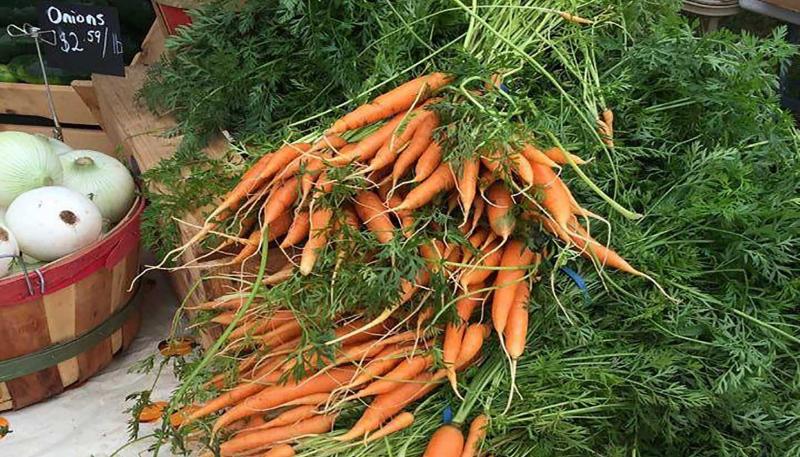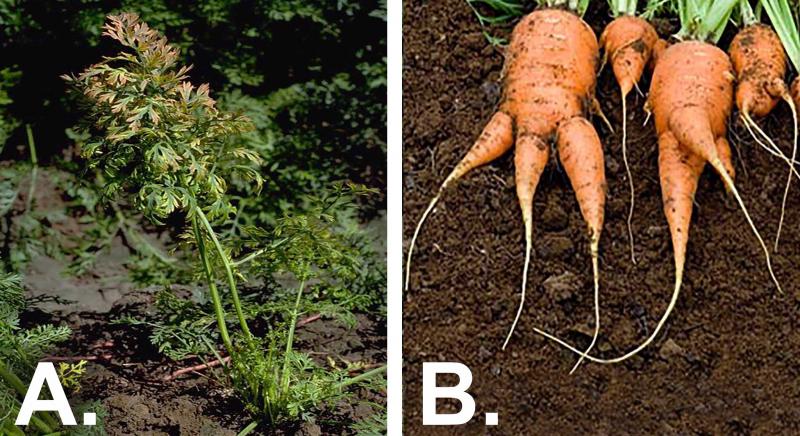Written by Rhoda Burrows, former Professor & SDSU Extension Horticulture Specialist.
Description

General Description: Carrot is a hardy, cool-season vegetable. Carrots are eaten both raw and cooked and they can be stored for winter use.
Types: Small/Round, Baby, Chantenay, Danvers, Nantes, Imperator, and Novelty. In heavy soils, the shorter more cone-shaped varieties such as the Danvers type, may be easier to grow and harvest.
Color Variations: Orange, purple, yellow, red and white. Purple carrots tend to be very sweet.
Fun Fact: Carrots have one of the most complex flavor profiles of all vegetables. In addition to the level of sweetness, other flavor compounds can cause light fragrances, fruitiness, or even bitter tastes like pinecones!
Planting

Timeline: Carrots can be planted as soon as the soil reaches 40°F, around mid-April, though they will germinate more quickly in warm soil (Figure 2). Days to Harvest: 55-80 days, depending on variety.
Sowing: Sow carrot seed directly into the soil. Plant ¼ to ½ inch deep. Pelleted seed or seed tapes can be used to help obtain proper spacing. Carrots should never be transplanted, otherwise, as they develop, the roots will fork. Seeds may take as long as 3 weeks to germinate, and the soil must be kept moist during that time period.
Thinning: Thin carrots once they reach a small edible size (the foliage will be 3 to 4-inches tall): Pull up any extra carrot seedlings that are too closely spaced, so that the remaining carrots are spaced about 2- or 3-inches apart. Otherwise, the roots will not develop properly.
Plant Care
Watering: Vegetables need at least 1 inch of water each week during the growing season from rainfall or irrigation. Always soak the soil thoroughly when watering. Carrots growing in dry soil may become misshapen, or develop a bitter taste.
Fertilizing: 2 to 3 tablespoons of lawn fertilizer (make sure it does not have an herbicide in it) may be applied to 10 ft. of row, once carrots are about 4 inches tall. Too much nitrogen will decrease root growth. If growing in a container with artificial soil, apply an all-purpose fertilizer such as 10-10-10 or 10-15-15 according to package instructions.
Weeding: Young carrots are weak and grow slowly. It is essential to keep weeds under control for the first few weeks. Cultivate very carefully to avoid injuring roots. Mulching with several inches of clean straw, herbicide-free grass clippings, or similar materials can help keep weeds down, and provide cooler soil temperatures to keep the carrots sweeter in taste.
Pests and Diseases

Major Pests
- Carrot Root Flies: Maggots that feed on and destroy the roots of many root crops. Control by harvesting plants as soon as possible. Do NOT apply insecticides to plant parts that are to be eaten.
Major Diseases
- Aster Yellows: Common symptoms of this disease are hairy roots and yellow or purplish tops (Figure 2-A). This disease is spread by plant-sucking insects called aster leafhoppers.
Minor Problems
- Forked Roots: May be due to rocky or stony soil or heavy soil (Figure 2-B). Transplanting can also lead to forked roots.
- All Tops: All tops and no roots or small roots is a condition usually caused by planting too close or by not thinning plants.
- Sunburning: Causes carrots to turn green on the top of the root. Can be avoided by mounding soil up to the row when the roots are swelling.
Harvest and Storage
Harvest: Carrots are usually harvested when the roots are ¾ inches in diameter at the upper end, but you can harvest them any time they reach a usable size. To harvest, put the root to the side and pull it out of the ground. If you are removing the entire crop at one time, it may be helpful to use a spading fork to loosen the soil next to the plants before pulling them.
Average Yield: 10 -to-12 pounds per 10-foot row.
Storage: Store carrots in a cool, humid place with temperatures ranging from 32°- 40°F.
Preparation
Nutrition Facts: Fat free, cholesterol free, good source of fiber, high in beta-carotene, and high in Vitamin A.
Cooking Tips: For more details on preparing and preserving carrots, see our Pick it! Try it! Like it! resource for carrots.


